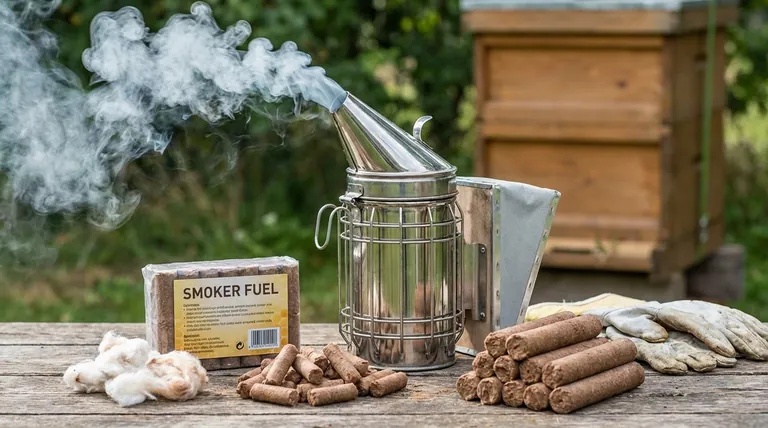The primary advantages of using cotton as a smoker fuel are that it produces a cool, consistent smoke, lasts significantly longer than other fuels, and does not leave a gummy resin residue. Its main disadvantage is that it can be difficult to find, requiring beekeepers to stock up when they locate a source.
The choice of a smoker fuel is not a minor detail; it's a critical decision that directly impacts the safety of your bees and the efficiency of your hive inspections. Cotton is widely considered the superior fuel because it excels at producing cool, long-lasting smoke that is safest for the colony, with its only real drawback being availability.

Why Cotton is a Top-Tier Smoker Fuel
To understand why many experienced beekeepers prefer cotton, we need to look at the key characteristics of an ideal fuel. The goal is to calm the bees with minimal disruption or harm.
The Critical Importance of Cool Smoke
The most significant benefit of cotton is the temperature of the smoke it produces. Cotton smolders slowly without an open flame.
This smoldering action generates a cool smoke that pacifies the bees without harming them. Hot smoke, produced by fuels like pine needles or cardboard that burn with an open flame, can injure or kill bees and even damage the queen.
Unmatched Burn Duration and Consistency
Cotton's slow, smoldering burn means it lasts up to three times longer than many other common fuels, such as burlap.
This longevity is highly practical during hive inspections. It reduces the need to constantly refuel the smoker, allowing you to work uninterrupted and with a consistent, reliable source of smoke.
Clean Burning, No Gummy Residue
Many wood-based fuels, like pine needles and wood pellets, contain natural resins. When burned, these resins create a sticky, tar-like substance that gums up the smoker lid and components.
Cotton is a clean-burning fuel that does not contain these resins. This keeps your equipment cleaner, ensures it functions reliably, and reduces the time you spend on maintenance.
Understanding the Trade-offs and Alternatives
While cotton's performance is excellent, practical considerations and availability lead beekeepers to use other materials.
The Primary Challenge: Availability
The main con of cotton is straightforward: it can be difficult to source. It isn't typically sold in standard stores.
Because of this, beekeepers who prefer cotton often buy it in bulk when they find a reliable supplier. Untreated cotton rags or specialty beekeeping cotton are common forms.
How Cotton Compares to Common Fuels
Evaluating alternatives highlights the specific advantages cotton provides.
- Burlap: Often considered the next-best option. It also smolders and produces cool smoke without gumming up the smoker. However, it burns much more quickly than cotton.
- Wood Pellets & Pine Needles: These are readily available but burn with an open flame, creating hot smoke. They also contain resins that will build up inside your smoker.
- Cardboard: While easy to find, corrugated cardboard produces some of the hottest smoke of any fuel type and burns very quickly.
Making the Right Choice for Your Apiary
Your choice of fuel should align with your priorities for bee safety, convenience, and cost.
- If your primary focus is bee safety and maximum efficiency: Cotton is the undisputed best choice due to its cool, long-lasting, and clean smoke.
- If your primary focus is good performance from an available material: Burlap is an excellent and widely used alternative, just be prepared to refuel more often.
- If your primary focus is using what's freely available: Materials like pine needles or dry leaves can work, but you must manage them carefully to avoid overheating the smoke and harming your bees.
Ultimately, selecting a fuel that smolders coolly and burns cleanly is a fundamental step toward responsible and effective beekeeping.
Summary Table:
| Fuel Type | Pros | Cons |
|---|---|---|
| Cotton | Cool, safe smoke; long-lasting burn; no gummy residue | Difficult to source; requires bulk purchasing |
| Burlap | Cool smoke; widely available | Burns quickly; requires frequent refueling |
| Wood Pellets/Pine Needles | Readily available | Hot smoke; open flame; leaves sticky resin |
| Cardboard | Easy to find | Very hot smoke; burns extremely fast |
Ready to optimize your hive inspections with the best smoker fuel? For commercial apiaries and beekeeping equipment distributors, HONESTBEE is your trusted wholesale partner for high-quality beekeeping supplies. We provide the reliable equipment and fuels you need for efficient, bee-safe operations. Contact us today to discuss your wholesale needs and ensure your apiary's success!
Visual Guide

Related Products
- 54-Piece Smoker Fuel Pellets for Beekeeping Beehive Smoker Fuel
- Stainless Steel Honey Bee Smoker Hive and Honeycomb Smoker for Beekeeping
- Premium Traditional Copper Bee Smoker with Bellows
- Economy Galvanized Beekeeping Honey Bee Smoker for Wholesale
- Professional Bee Smoker with Elongated Spout and Durable Bellows for Beekeeping
People Also Ask
- What to put in a bee hive smoker? A Guide to Natural, Calming Fuels
- What is best to burn in a bee smoker? Master the Layered Fuel Technique for Calm Hives
- What is the importance of fuel in a bee smoker? Ensure Cool, Calming Smoke for Your Hive
- What is the best bee hive smoker fuel? Choose Natural, Slow-Burning Fuel for Calm Bees
- What can I use for bee smoker fuel? Choose Safe, Natural Materials for a Calm Hive



















